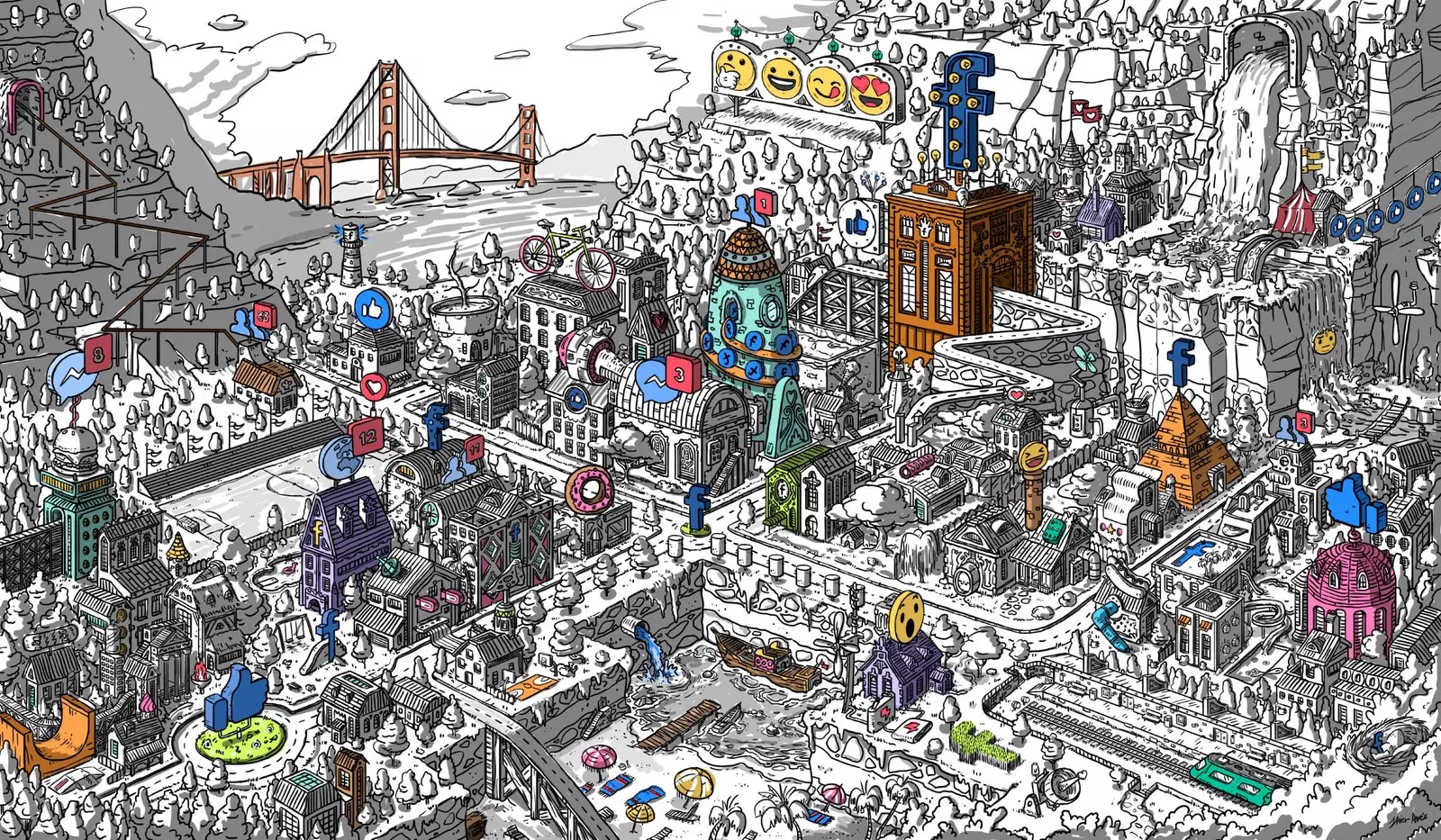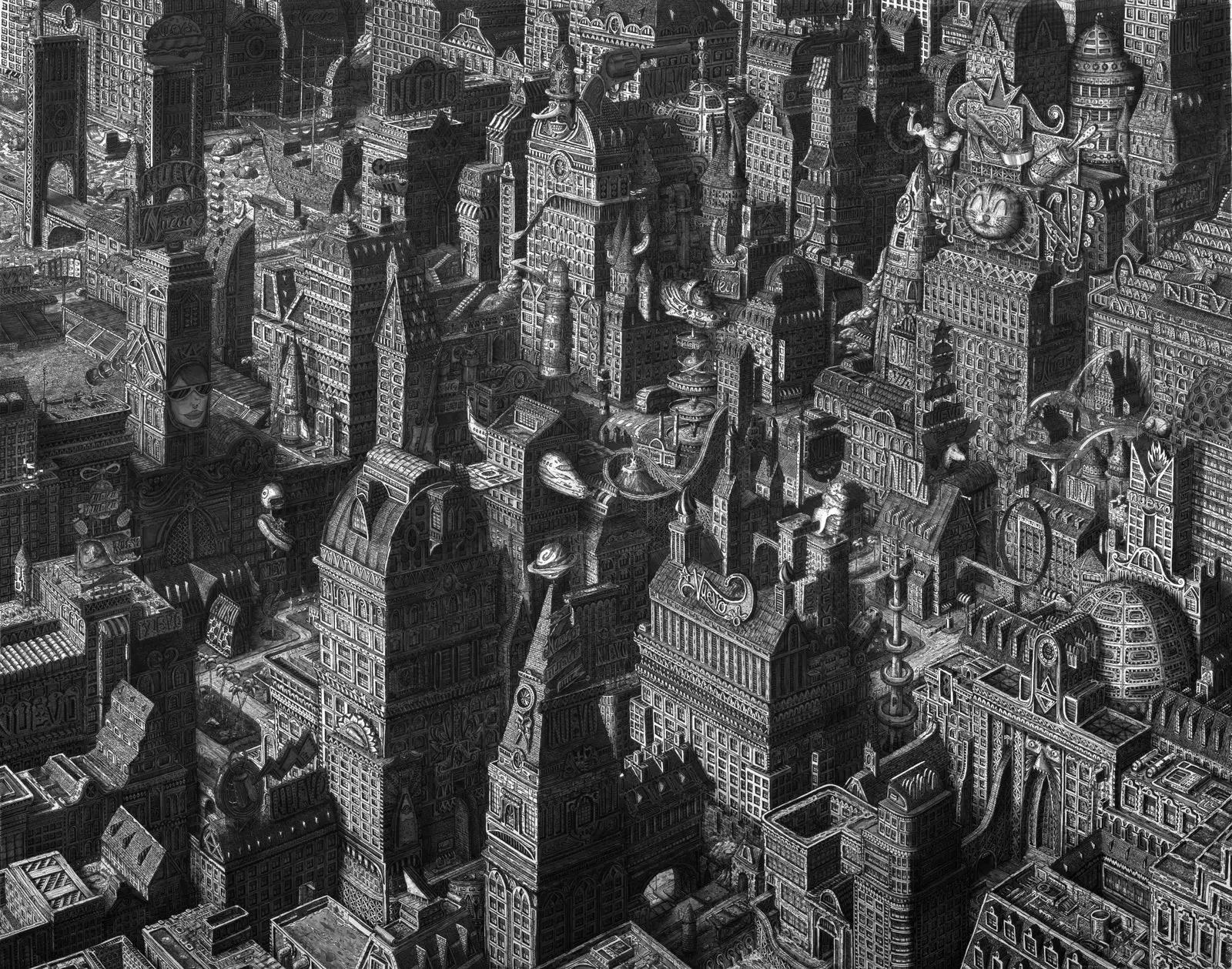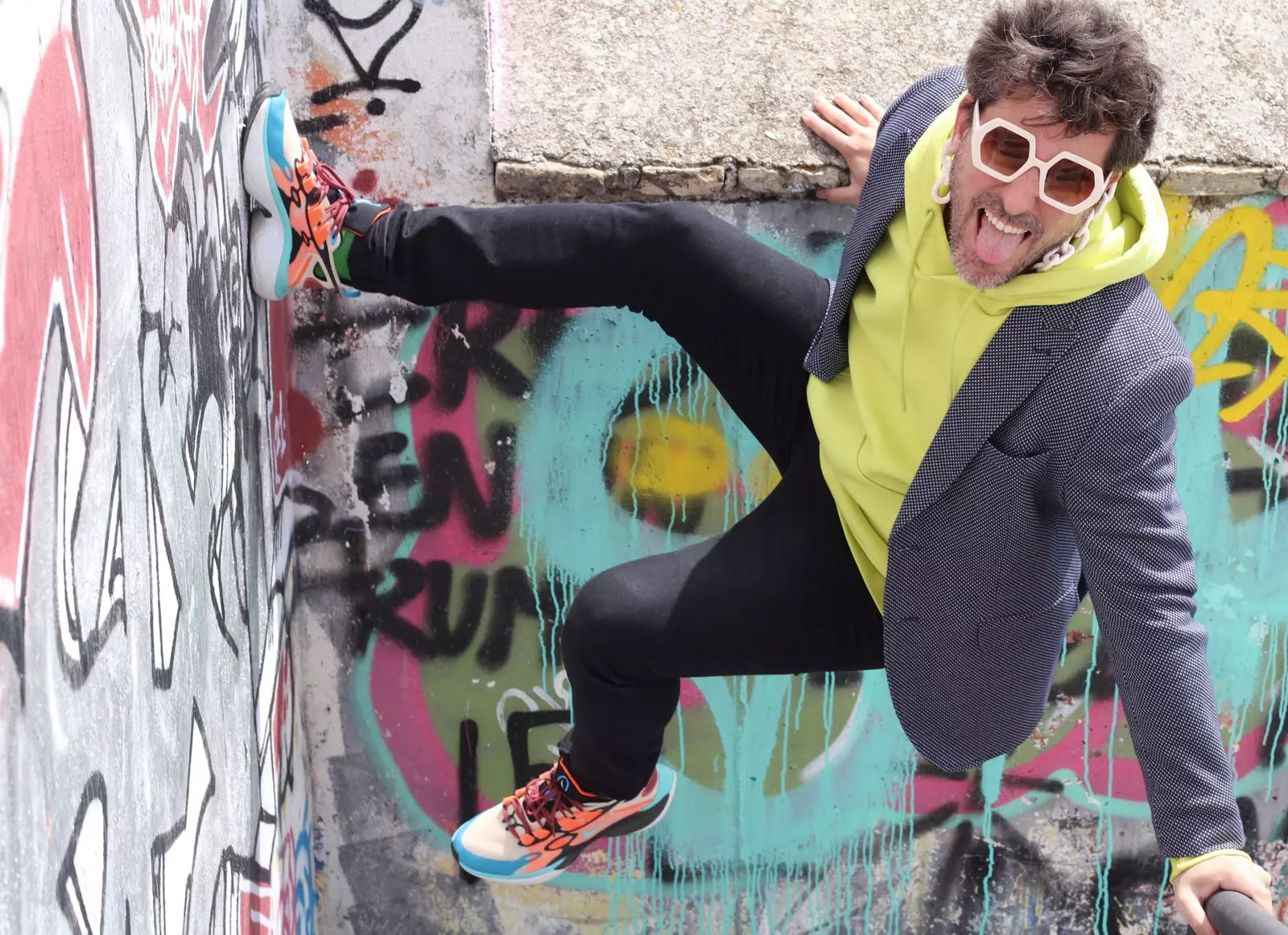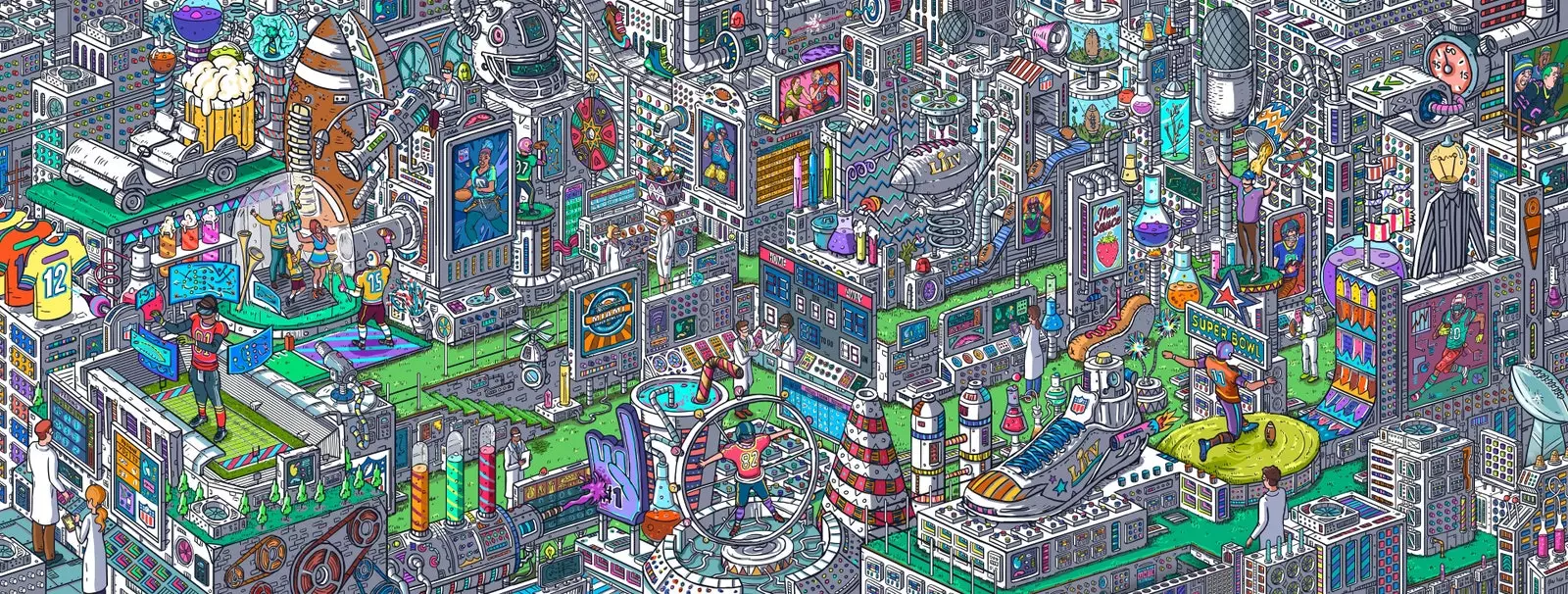
'Zucktown - New York Times', the work of the crypto-artist Javier Arrés.
Crypto art is a real revolution, he claims Javier Arrés (Motril, 1982), winner of the London Art Biennale 2019 with its detailed and spectacular work of art Capitol City. And this crypto artist, pioneer in our country and recognized internationally, he knows very, very well what he is talking about, since he is one of the few Spaniards who have managed to auction and sell your non-fungible tokens (NFTs) through a virtual gallery. His work The Cool Glasses Crazy Machine (1/1 edition) brought him almost 40 thousand dollars, and he can boast of having been among the best-selling artists in the world.
But, What are NFTs and how are they credited? Why can you consume –even download– the works that we share in this article even though they may have an owner who has paid for them and owns them? How Is 'the digital' revolutionizing the art world? To answer these and other questions, we have asked Javier Arrés, who has told us, among many other things, that although his passage through the Fine Arts career was discouraging (“The system, the operation, the extreme academicism, etc. For me that was a factory in Bangladesh where everything was to get a grade or pass.”) he never stopped creating and drawing on his own, something he's actually been doing since he was a kid.

Javier Arrés won the London Art Biennale in the ink works category in 2019 with 'Capitol City'.
Condé Nast Traveler: When did you know that art (illustration) would be your profession? And when did it come true?
Javier Arres: I always thought it would be possible to make a living doing this, since I've been doing it since I was little. However, knowing that I could live 100% of my work, I felt this about three or four years ago, when had important clients and my work began to interest internationally. After I won the London Art Biennale and sold my work within a few hours, And then I knew I could. All after many years of work, assignments and effort. This profession requires many sacrifices. Mine is hard work without anyone asking me and never give up.
CNT: When did you know that NFTs would be the future? (although they are already the present).
J.A.: When the founder of Makersplace contacted me almost two years ago he knew nothing about NFTs, or crypto art, but he had suffered the problem that this came to solve: the sale of unique digital original work. Keep in mind that I had already developed my collection of Visual Toys (gif-arts), it had been exhibited internationally and had already aroused interest in collectors, but it was not possible to sell it. It was the problem that we who were in that front of the most avant-garde art. So, when the issue of NFTs was explained to me, I understood that I could succeed, because I came to solve this issue. Shortly after seeing how that market moved and the profiles that were in it, I understood that the future lay in the way of crypto art.

The crypto artist Javier Arrés.
CNT: You are a pioneer in crypto art. Does arriving among the first give you a greater guarantee of success by always being a benchmark?
J.A.: Being the first has a value that cannot be denied. Positions you as a visionary, but because in reality I was and therein lies the lesson that I think is most important. My Visual Toys seem to have been created for the world of crypto art, but they were made many years before and they didn't make money. I created them because I am a creator and my ink work asked for movement, and I gave him what he asked for without caring if it was profitable or not. In fact, it was impossible to sell them, but I loved them and those who saw them too. Once the opportunity came, I already had a truck full of work for that market.
CNT: It has nothing to do with artistic reinvention then...
J.A.: I am not now reinventing myself for this and, by the way, I mentioned it to several Spanish artist friends of mine and they looked at me like a crazy person. There was jokes and jokes, the usual, but now they don't stop sending me e-mails. It's not about that It's about developing your work. One must go forward into the unknown with courage and get on the train –that the experience in his work tells him– and take risks. I did, I worked hard for nothing and now I'm here for that, I'm the pioneer. Also I can be the pioneer in giving myself the big slap, this is so.
CNT: How is the authenticity of an NFT work guaranteed and how are copyrights protected?
J.A.: The NFT is just the strongest guarantee of authenticity. Creating an NFT creates a blockchain contract in which everything is reflected: authorship, transfers, etc. Have full traceability, always showing where the work is and if it is resold.
CNT: Besides, in each future resale of one of your works, you would collect part of it again, right?
J.A.: That's how it is. From each resale I receive the 10% royalty.
CNT: You can even split a sale...
J.A.: Yes. For collaborative works they can be indicated very easily who are their authors and what percentage of the work they have. Royalties are also divided. It is the best way to do a collaborative work, because everything is very clear and reflected forever. There would be no future problems regarding authorship.

'American Football Laboratory. The Mural', work for the NFL by Javier Arrés.
CNT: In this way, since it is a virtual sale, quite a few intermediaries are eliminated in the purchase process...
J.A.: A lot of. From the gallery owner, with his high percentage, to the transport of the work, insurance, etc. The platforms remain a few percent, but it is a ten, nothing comparable to the traditional market, where the normal is between 30 and 50%.
CNT: Where do you exhibit your works?
J.A.: They are all found on the Makersplace platform. Although they have been exhibited at international fairs and festivals, both ink and digital works, the Visual Toys mainly.
CNT: How would you define your style?
J.A.: Good is a very ornate and ornate style, compositional tangles where architecture, buildings, and also an urban and design spirit are always the protagonists, with large letterpress signs. But what I do is combine everything I like to create whether it's machines or crazy objects full of technology or fantasy cities. there are also many popular elements or icons, like the hot dog, the churros, roller coasters… everything. It is best to see it.
CNT: I see many references to the industrial world...
J.A.: Yes. I really like machinery and everything industrial; to create funny and impossible technological objects of unknown function or stuff like that. Something that has buttons is because it has a function and invites us to imagine its objective or to press these buttons. It comes from my fascination with certain movies, like Alien, a whole combination of technology and a lot of industrial environment combined with the organicity of Alien, also Futurama, 2001 A Space Odyssey... There are many buttons and wires (jokes).
CNT: And plenty of food...
J.A.: The truth is that I have a lot of work dedicated to food. A lot. I believe that the culinary world invites a lot to play, to create fun combinations and also It has a very captivating element for the viewer, that he would like to try that food, he wonders what it tastes like and, albeit in an imaginary way, also it is suggestive. Churros, Singapore's spicy food and coconut jam , pizza, hot dog, hamburger, taco… I have a lot, I have fun.
CNT: How long can it take you to make a work?
J.A.: A Visual Toy like Who is Satoshi Nakamoto?, about two and a half weeks easily. An ink work, like the one that won the London Art Biennale, about two and a half months. But, to give another example, each pair of glasses from The Cool Glasses collection has been around 13 hours. My work requires a lot of work and hours, It is very elaborate and full of details.
CNT: How many works have you sold and which one has brought you the most profit?
J.A.: About 90 works. A few months ago I was the top 16 in the world in sales. The unique work, edition 1/1, that has reported me the most has been the one from the last auction: The Cool Glasses Crazy Machine, which sold for 37 thousand dollars.
CNT: Is Capitol City your favorite because of the success and the prize won?
J.A.: It could be said that it is my favorite or, at least, I owe it a lot and it is very, very special to me. I did it with great freedom and great enthusiasm, I was unemployed and I invested almost three months to make it. I had been developing my style for a while, but there I decided to take it to the maximum, since he had the time available. I remember being very happy creating it.
CNT: What are your Visual Toys?
J.A.: My Visual Toys are very crazy gif-arts that look like a toy or object full of movement and very overloaded with details and little secrets in an infinite loop. I decided to call them that because, for me, their function or purpose is the same as that of a toy, entertain and invite to imagine, in this case in a visual way. I usually invite them to see one of my Visual Toys and let themselves go. One of my favorite things is hearing what the viewer thinks of them when they see them, it's magical for me because my goal is fulfilled. People get excited and tell me it reminds them of this or that, or that it is used for one thing or another… It is always great, because there are as many different visions as there are spectators. It is fun.
CNT: Illustration and animation are increasingly inseparable…
J.A.: The animation brings something else. It doesn't have to be an extreme or complex animation, just trees moving a little in the wind, a flashing neon on a billboard, birds passing in the distance... sometimes this is enough. I think it always gives you something more, if you know how to use it correctly.
CNT: Is the future (of the future) of crypto art digital frames signed or authenticated as unique by the artist?
J.A.: That is a very clear path and one that has not yet been fully implemented. But the future is also to have your own gallery in the metaverse or on other platforms. The virtual world itself is already a place to have and enjoy, and that world will become more and more important.
CNT: The possibilities of virtual art are endless…
J.A.: I don't know if there is something that is infinite, I don't think so, but of course the possibilities are many more than we imagine. We are very early and there is a whole new world to explore. Incredible projects will arise that we cannot imagine yet. There are a lot of territory to conquer and that's fantastic.
CNT: An encrypted Beeple jpg was worth nearly $70 million, a Dorsey tweet nearly $3 million... Is it time to change the mindset in the art world?
J.A.: Yes, but it is complex and it is normal that it costs. That is a total remodeling of an area in which actors such as galleries – which have been operating in a very similar way for centuries – are going to find themselves in serious trouble if they do not update and try to understand this phenomenon and what is its place in it, which in many cases can be its disappearance.
Crypto art does not come to destroy traditional art, it is something else that is added and cohabits creatively speaking, but the sales model has undergone a very strong change when fall the elitist wall of collecting, making this world open and much more democratic for everyone. Many intermediaries disappear and the market begins to speak for itself by being so free.
This topic is very interesting and broad, many artists and galleries have contacted me and are already trying to adapt. It is a real revolution that mainly favors artists of any rank.
